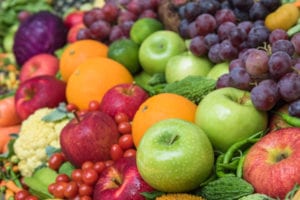Written by Greg Arnold, DC, CSCS. This article discusses the benefits of consuming more than (5) fruits and vegetables per day, which was linked to a 47% lower mortality rate compared to those who did not consume fruits and vegetables.
 When it comes to strategies to help prevent the chronic diseases that affect our society (cardiovascular disease, diabetes, Alzheimer’s disease, cancer), one of the simplest approaches has been to consume more fruits and vegetables, with the most current recommendations by the National Cancer Institute being at least 5 servings per day 1.
When it comes to strategies to help prevent the chronic diseases that affect our society (cardiovascular disease, diabetes, Alzheimer’s disease, cancer), one of the simplest approaches has been to consume more fruits and vegetables, with the most current recommendations by the National Cancer Institute being at least 5 servings per day 1.
Research on fruit and vegetable consumption has focused most commonly on cardiovascular disease 2,3 and cancer 1. Now a new study 4 provides more specific proof on fruit and vegetable consumption leading to longer life.
In the study, 38,221 men from the Cohort of Swedish Men 5 and 33,485 women with an average age of 60 from the Swedish Mammography Cohort 6 completed a 96-item food-frequency questionnaire, including 14 questions on specific vegetables (carrot, beetroot, lettuce, cabbage, cauliflower, broccoli, tomato) 5 questions on specific fruits (orange, apple, banana, berry, and other fruit), and 1 on orange juice 7. The researchers observed a significant benefit of fruit and vegetable consumption on lifespan. Adjusting for smoking status so the effect of fruit and vegetable consumption could be isolated, those consuming more than 5 fruits and vegetables per day lived three years longer and had a 47% lower mortality rate than those who did not consume fruits and vegetables.
This lifespan benefit of fruit and vegetable consumption seemed to be significantly influenced by the antioxidant properties of fruits and vegetables as those consuming the highest amounts of fruits and vegetables (>6 servings/day) had only 2% lower body mass index (BMI) (25.1 vs 25.6 kg/m2, p < 0.001), 1.9% higher rates of physical activity (42.6 vs 41.8 MET-h/day, p < 0.001), and 17.2% higher calorie consumption (2413 vs 2058 calories/day, p < 0.001) compared to those with the lowest levels of fruit and vegetable consumption (< 2 servings/ day).
This antioxidant component, coupled with a 47% lower rate of current smokers in the highest consumption group (18% vs 34%, p < 0.001), suggests that longer life may indeed be strongly influenced by oxidative stress and cell damage by free radicals, a theory proposed for decades 8. But as the 47% reduced rate of death only produced a 3-year increase in lifespan, it may have been because the subjects were near the end of life when this study was conducted. Unfortunately, the researchers did not provide data on the age of death between subjects in each group.
For the researchers, “the findings from this prospective study indicate that FV consumption, 5 servings/d is associated with progressively shorter survival and higher mortality rates” and that “fruit and vegetables consumption < 5 servings/day does not provide considerable added benefits with respect to survival.”
Source: Bellavia, Andrea, et al. “Fruit and vegetable consumption and all-cause mortality: a dose-response analysis.” The American journal of clinical nutrition 98.2 (2013): 454-459.
© 2013 American Society for Nutrition
Posted September 4, 2013.
References:
- Boffetta P, Couto E, Wichmann J, et al. Fruit and vegetable intake and overall cancer risk in the European Prospective Investigation into Cancer and Nutrition (EPIC). J Natl Cancer Inst. 2010;102(8):529-537.
- Bazzano LA, Serdula MK, Liu S. Dietary intake of fruits and vegetables and risk of cardiovascular disease. Curr Atheroscler Rep. 2003;5(6):492-499.
- Dauchet L, Amouyel P, Dallongeville J. Fruit and vegetable consumption and risk of stroke a meta-analysis of cohort studies. Neurology. 2005;65(8):1193-1197.
- Bellavia A, Larsson SC, Bottai M, Wolk A, Orsini N. Fruit and vegetable consumption and all-cause mortality: a dose-response analysis. Am J Clin Nutr. 2013;98(2):454-459.
- Trials.gov C. Cohort of Swedish Men. Available at: https://clinicaltrials.gov/ct2/show/NCT01127711.
- Trials.gov C. Swedish Mammography Cohort (SMC). The Swedish Mammography Cohort began in 1987-1990, when 1966,1651 women living in two counties in central Sweden completed a mailed questionnaire that included items about their diet, parity, age at first child’s birth, history of breast cancer in family, weight, height, and education. Follow-up questionnaires have been sent out in 1997 and in 2008-1909. Available at: https://clinicaltrials.gov/ct2/show/NCT01127698.
- Hansson LM, Galanti MR. Diet-associated risks of disease and self-reported food consumption: how shall we treat partial nonresponse in a food frequency questionnaire? Nutr Cancer. 2000;36(1):1-6.
- Harman D. Aging: a theory based on free radical and radiation chemistry. J Gerontol. 1956;11(3):298-300.
